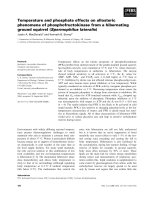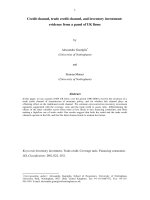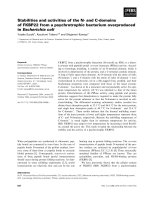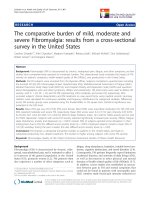Bacteriological profile and antibiogram of uropathogens from a tertiary care hospital: A two year retrospective analysis
Bạn đang xem bản rút gọn của tài liệu. Xem và tải ngay bản đầy đủ của tài liệu tại đây (330.18 KB, 7 trang )
Int.J.Curr.Microbiol.App.Sci (2019) 8(1): 1206-1212
International Journal of Current Microbiology and Applied Sciences
ISSN: 2319-7706 Volume 8 Number 01 (2019)
Journal homepage:
Original Research Article
/>
Bacteriological Profile and Antibiogram of Uropathogens from a Tertiary
Care Hospital: A Two Year Retrospective Analysis
Shivani Raina and Dipender Kaur Najotra*
Deptt. of Microbiology, Acharya Shri Chander College of Medical Sciences and Hospital
Jammu, Jammu and Kashmir, India
*Corresponding author
ABSTRACT
Keywords
UTI, Uropathogen,
Bacteriology,
Antibiogram,
E. coli
Article Info
Accepted:
10 December 2018
Available Online:
10 January 2019
Urinary tract infections (UTIs) are one of the most common bacterial infections
encountered in clinical practice. The knowledge of etiology and antibiogram of
uropathogens helps in starting empirical treatment till the results of antibiotic susceptibility
is awaited. Therefore this two year retrospective study was undertaken to determine the
bacteriology and antimicrobial susceptibility pattern of UTIs in a tertiary care hospital.
Urine samples from patients suspected of having UTI were processed according to
standard microbiological techniques. Bacterial pathogens were isolated, identified and
antimicrobial susceptibility testing was done by Kirby Bauer Disc Diffusion from 286
culture positive samples. Escherichia coli with 186(65%) isolates was predominant
followed by Klebsiella pneumoniae 30(10.5%), Pseudomonas aeruginosa 20(7%),
Enterococcus spp. 13(4.6%), Proteus spp. 10(3.5%), Acinetobacter spp. 8(2.8%),
Staphylococcus aureus 7(2.4%) and Coagulase negative Staphylococci (CoNS) 6(2.1%).
Antibiogram of these bacteria suggests that empirical therapy to cover gram negative
bacteria can be started with imipenem or piperacillin /tazobactum or nitrofurantoin. In
selected cases vancomycin or linezolid can be added to give gram positive coverage. But
in view of the increasing drug resistance antimicrobial susceptibility should be done and
definitive therapy started immediately.
Introduction
Urinary tract infections (UTI) include various
conditions ranging from asymptomatic
bacteriuria to severe renal infections resulting
into sepsis and can affect any part of the
urinary tract from the bladder to the kidney
(Kumar et al., 2016, and Flores-Mireles et al.,
2015). It is estimated that annually, worldwide
7 million and 1million patients with UTI
attend the outpatient and emergency
department respectively. Whereas 100,000
hospitalizations occur annually due to UTI
(Wilson et al., 2004). Most of the times these
UTIs are treated empirically without any
antibiotic susceptibility testing which leads to
increased drug resistance in bacteria against
commonly used antibiotics (Chiu, 2013). Also
in the last two decades it has been seen that
the trend of bacterial isolates obtained and
their antibiotic sensitivity pattern keeps on
1206
Int.J.Curr.Microbiol.App.Sci (2019) 8(1): 1206-1212
changing (Ram et al., 2000).
Therefore updated information regarding
profile
of
uropathogens
and
there
susceptibility to various antibiotics should be
readily available to the clinicians for the
development of local data to start appropriate
empirical therapy (Majumder et al., 2018; Oli
et al., 2017; Vakilwala et al., 2012 and Ko et
al., 2008). So with this background, the
present study aimed at investigating the
bacterial agents responsible for UTIs in a
tertiary care hospital setting and study their
antibiotic susceptibility pattern.
Materials and Methods
This retrospective study was conducted in a
tertiary care hospital over a period of two
years, from January 2016 to December 2017
after approval from institutional ethical
committee. Clean catch midstream urine or
catheterized urine samples were collected in a
wide mouthed sterile screw capped containers
from suspected patients of UTI. Urine samples
were taken to bacteriology lab and processed
immediately within half an hour of collection.
Samples were inoculated semiquantitatively
with calibrated loop on Blood agar and
McConkey agar and incubated aerobically
overnight at 37⁰C. Pure growth of a single
microorganism with a colony count of >105
colony forming units (cfu)/mL of urine was
considered as significant bacteriuria (Stamm
et al., 1983). Further, the significant isolates
were identified by conventional biochemical
methods
according
to
standard
microbiological techniques (Collee et al.,
2006). Antibiotic Susceptibility Testing was
done on Mueller- Hinton agar by Kirby
Bauer's disc diffusion method, according to
the CLSI guidelines, 2016. The following
antimicrobial discs (µg) were used:
amoxicillin clavulanic acid (20/10μg),
piperacillin tazobactam (100/10μg), amikacin
(30μg), co-trimoxazole (25μg), gentamicin
(10μg), tobramycin (10μ g), nitrofurantoin
(300μg), cefepime (30μg), cefotaxime (30μg),
cefuroxime (30μg), ceftazidime (30μg),
imipenem (10 μg), Polymyxin B(300U),
Penicillin(10U),
ciprofloxacin
(5μg),
norfloxacin (10μg), vancomycin (30μg),
Linezolid (15μg). Escherichia coli ATCC
25922 Staphylococcus aureus ATCC 25923
were used as control strains.
Data management and statistical analysis
Statistical Package for Social Science (SPSS)
Software, version 16 was used for data
analysis. Chi-square test was performed to
obtain the correlations between variables.
Results and Discussion
During the study period, 984 urine samples
were analyzed out of which 286 (29.1%) were
culture positive. Of these culture positive
samples, 173 (60.5%) were from female
patients and 113 (39.5%) from male patients.
Of the 286 isolates, 254 (88.8%) were Gram
negative bacilli, 26 (11.2%) were Gram
positive cocci and 6 (2.1%) were Candida spp.
Amongst the Gram negative isolates,
Escherichia coli with 186(65%) was
predominant
followed
by
Klebsiella
pneumoniae 30 (10.5%), Pseudomonas
aeruginosa 20 (7%), Proteus spp. 10(3.5%)
and Acinetobacter spp. 8 (2.8%), (p=0.0001
significant). Amongst Gram positive isolates,
Enterococcus spp. 13(4.6%) was commonest
followed by Staphylococcus aureus 7(2.4%)
and Coagulase negative Staphylococcus
6(2.1%) (Fig. 1).
As far as antibiogram of gram negative
bacteria is concerned, Imipenem was the most
effective drug with sensitivity ranging from
80-100%. Piperacillin/tazobactum showed
good sensitivity against Proteus spp (80%)
and E.coli (77.4%). Amikacin had good
sensitivity profile against E. coli (79.6%) and
1207
Int.J.Curr.Microbiol.App.Sci (2019) 8(1): 1206-1212
Proteus spp. (70%). Nitrofurantoin was also
an effective antibiotic against E. coli with
81.2% sensitivity. Polymyxin B was quite
effective against Pseudomonas spp. and
Acinetobacter spp with 95% and 87.5%
sensitivity respectively. Gram negative
bacterial isolates were highly resistant to
cotrimoxazole,
fluoroquinolones
and
cephalosporins like cefepime, cefotaxime,
ceftazidime, cefuroxime (Table 1).
Gram positive isolates showed 100%
sensitivity to Linezolid and Vancomycin.
Nitrofurantoin also turned out to be effective
with Staphylococcus aureus showing 100%
sensitivity and CoNS 83.3%. Fifty or less than
fifty percent gram positive isolates were
resistant to Norfloxacin. Majority of the gram
positive bacteria were resistant to Penicillin
and Co-trimaxazole (Table 2).
This study gives an insight into UTI, one of
the most common infections leading to an
antibiotic prescription from a tertiary care
hospital. The culture positivity rate was 29.1%
from 984 urine samples received from the
patients attending the hospital with the
symptoms suggestive of UTI. This prevalence
rate was similar to various national and other
studies from the developing world (Majumder
et al., 2018; Khadka et al., 2012; Joshi et al.,
2016; Thattil et al., 2018 and Mandal et al.,
2012). Greater prevalence of UTI was seen in
females accounting for 60.5% of the positive
samples, similar to other studies worldwide
(Khadka et al., 2012; Joshi et al., 2016; Razak
et al., 2012; Singh et al., 2017; John et al.,
2015 and Mohammed et al., 2016). The
predominant uropathogen in our study was E.
coli followed by K. pneumoniae which is in
agreement with many other studies from India
and abroad (Majumder et al., 2018; Vakilwala
et al., 2012; Khadka et al., 2012; Thattil et al.,
2018; Razak et al., 2012; John et al., 2015 and
Mohammed et al., 2016).
effective against more than 80% gram
negative isolates as reported by numerous
other studies (Majumder et al., 2018; Thattil et
al., 2018; Singh et al., 2017; Mohammed et
al., 2016; Vecchi et al., 2013 and Rangari et
al., 2015). Piperacillin/ tazobactum showed a
sensitivity of around 80% for E.coli and
Proteus spp. isolates and around 65% for
Pseudomonas which is in concordance with
many previous studies (Thattil et al., 2018;
Vecchi et al., 2013; Rangari et al., 2015 and
Singla et al., 2015). This drug was least
effective against Acinetobacter as reported by
Berry et al., (2013). Amikacin also proved to
be a good alternative against E. coli, Proteus
spp. and Pseudomonas spp. but had limited
activity against Acinetobacter isolates which
is in harmony with other studies (Vakilwala et
al., 2012; Joshi et al., 2016; Razak et al., 2012
and Vecchi et al., 2013). Nitrofurantoin turned
out is very active against E. coli which is the
predominant urinary isolate similar to
previous reports (Majumder et al., 2018;
Rangari et al., 2015 and Singla et al., 2015
and Vecchi et al., 2013). High percentage of
resistance against Nitrofurantoin was seen
amongst isolates of other gram negative spp.
as reported by Joshi et al., (2016) and Thattil
et al., (2018). Gentamycin demonstrated a
sensitivity rate of 50-55% amongst most of the
species similar to few other studies (Joshi et
al., 2016; Mandal et al., 2012 and Rangari et
al., 2015). Majority of the gram negative
isolates were resistant to commonly used
cephalosporins and co-trimoxazole as also
reported by other researchers (Vakilwala et
al., 2012; Razak et al., 2012; Mohammed et
al., 2016; Rangari et al., 2015 and Singla et
al., 2015 and Berry et al., 2013).
Fluoroquinolones were also ineffective against
majority isolates similar to previous reports
(Razak et al., 2012; Rangari et al., 2015 and
Berry et al., 2013). Amoxycillin/ clavulanate
proved to be least effective in treating gram
negative UTI which is in concordance with
some other studies done by Majumder et al.,
In the present study imipenem was found to be
1208
Int.J.Curr.Microbiol.App.Sci (2019) 8(1): 1206-1212
(2018) and Thattil et al., (2018). As far as
gram
positive
cocci
are
concerned
vancomycin and linezolid were the most
effective with 100% sensitivity as reported
from many other places (Thattil et al., 2018;
Singla et al., 2015; Vecchi et al., 2013 and
Rangari et al., 2015). The next effective drug
against UTI due to gram positive cocci was
nitrofurantoin which is similar to previous
reports by Singla et al., (2015) and Vecchi et
al., (2013). Very high resistance was seen to
ciprofloxacin amongst enterococcal isolates
which was in line with other studies by Thattil
et al., (2018) and Rangari et al., (2015).
Table.1 Antibiotic sensitivity profile of Gram negative isolates (N=254)
Antimicrobial
agent
E.coli
(N=186)
K.pneumoniae Pseudomonas Proteus
(N=30)
(N=20)
(N=10)
Acinetobacter
(N=8)
Amoxycillin/
clavulanate
Piperacillin/
tazobactum
Amikacin
Cotrimoxazole
Gentamycin
Tobramycin
Nitrofurantoin
Ciprofloxacin
Norfloxacin
Cefepime
Cefotaxime
Cefuroxime
Ceftazidime
Imipenem
Polymixin B
25(13.4%)
0(0%)
1(5%)
3(30%)
1(12.5%)
144(77.4%) 12(40%)
13(65%)
8(80%)
2(25%)
148(79.6%) 10(33.3%)
48(25.8%) 9(30%)
10(50%)
6(30%)
7(70%)
0(0%)
2(25%)
4(50%)
105(56.5%)
151(81.2%)
56(30.1%)
30(16.1%)
49(26.3%)
39(21%)
21(11.3%)
45(24.2%)
185(99.5%)
-
11(55%)
10(50%)
3(15%)
6(30%)
5(25%)
5(25%)
5(25%)
1(5%)
6(30%)
16(80%)
19(95%)
5(50%)
5(50%)
5(50%)
3(30%)
2(20%)
2(20%)
4(40%)
2(20%)
2(20%)
10(100%)
-
4(50%)
6(75%)
2(25%)
1(12.5%)
2(25%)
1(12.5%)
3(37.5%)
1(12.5%)
2(25%)
8(100%)
7(87.5%)
8(26.7%)
2(6.7%)
10(33.3%)
5(16.7%)
5(16.7%)
2(6.7%)
2(6.7%)
3(10%)
28(93.3%)
-
Table.2 Antibiotic sensitivity profile of gram positive isolates (N=26)
Antimicrobial agent
Penicillin
Co-trimaxazole
Gentamicin
Ciprofloxacin
Norfloxacin
Nitrofurantoin
Vancomycin
Linezolid
Enterococcus spp.
S. aureus
CONS
(N=13)
(N=7)
(N=6)
1(14.3)
2(33.3)
3(23.1)
2(28.6)
1(16.7)
5(38.5)
5(71.4)
4(66.7)
4(30.8)
3(42.9)
4(66.7)
0(0)
2(28.6)
3(50)
4(30.8)
7(100)
5(83.3)
9(69.2)
7(100)
6(100)
13(100)
7(100)
6(100)
13(100)
Fig.1 Distribution of culture isolates
1209
Int.J.Curr.Microbiol.App.Sci (2019) 8(1): 1206-1212
Sensitivity of Stapyhlococcus aureus to
ciprofloxacin was 42.9% which is comparable
to other studies from UP and Nepal (Khadka
et al., 2012 and Rangari et al., 2015).
Gentamycin turned out to be effective against
70% of the staphylococcal isolates as reported
by other workers (Khadka et al., 2012; Vecchi
et al., 2013 and Rangari et al., 2015). On the
contrary Enterococcus isolates showed high
resistance to gentamicin which has also been
reported in few studies (Joshi et al., 2016 and
Thattil et al., 2018). Co-trimoxazole and
penicillin were also ineffective against
majority of the isolates as in other studies
(Khadka et al., 2012; Vecchi et al., 2013 and
Thattil et al., 2018).
Therefore this study concludes that E. coli is
the most likely organism encountered in UTI
and most of the strains isolated from a tertiary
care hospital are multi drug resistant.
Empirical therapy to cover gram negative
bacteria can be started with imipenem or
piperacillin /tazobactum or nitrofurantoin. In
selected cases vancomycin or linezolid can be
added to give gram positive coverage. But in
view of the increasing drug resistance,
antimicrobial susceptibility should be done
and definitive therapy started immediately.
References
Berry, B., Kedia, C., Grewal, L.K., Goyal, M.
2013. Acinetobacter: an opportunistic
uropathogen. Ind. J. Sci. Res. and
Tech.; 1(1):35-7.
Chiu, C. 2013. Definitions, classifications,
and antibiotics. In: Ran´e A, Dasgupta
R, editors. Urinary tract infection:
clinical perspectives on urinary tract
infection. London: Springer-Verlag. p.
1-10.
CLSI. 2016. Performance standards for
antimicrobial disk tests; Approved
Standards. 25th Edition. Clinical and
Laboratory Standards Institute (CLSI)
Document M2-A9. Wayne.; 26.(1).
Collee, J.G., Fraser, A.G., Marmion, B.P.,
Simmin, A. 2006. Mackie and
McCartney
practical
medical
microbiology, 14th Edition, Pearson
professional 1996, New York: 8485,152.
Flores-Mireles, A.L., Walker, J.N., Caparon,
M., Hultgren, S.J. 2015. Urinary tract
infections: Epidemiology, mechanisms
of infection and treatment options. Nat
Rev Microbiol. 13(5): 269-84.
[ />2] [PMID: 25853778].
1210
Int.J.Curr.Microbiol.App.Sci (2019) 8(1): 1206-1212
John, M.S., Meenakshi, K., Lakshmi, P.M.,
Reddy, P.S. 2015. Prevalence and
Distribution of Bacterial Pathogens
Causing Urinary Tract Infections in
Humans: A Study from Tertiary Care
Hospital
in
AP,
India.
Int.J.Curr.Microbiol.App.Sci.
4(2):
251-7.
Joshi, Y., Shrestha, S., Kabir, R., Thapa, A.,
Upreti, P., and Shrestha, S. 2016.
Urinary tract infections and antibiotic
susceptibility among the patients
attending B & D hospital of Lalitpur,
Nepal. Asian Journal Of Medical
Sciences,
7(5),
47-51.
doi:
/>908.
Khadka, K.S., Khadka, J., Lekhak, B.,
Shrestha, P. and Tiwari, B.R. 2012.
Incidence of urinary tract infection
among the patients visiting western
regional hospital, Pokhara, Nepal.
Journal of Health and Allied Sciences.
2(1):35-37.
Ko, M.C., Liu, C.K., Woung, L.C., Lee,
W.K., Jeng, H.S., Lu, S.H., et al.,
2008. Species and antimicrobial
resistance of uropathogens isolated
from patients with urinary catheter.
Tohoku Journal of Experimental
Medicine. 214(4): 311-19.
Kumar, G.V., Aaron, G., Viswanathakumar,
H.M. 2016. Study of clinical profile
and risk factors associated with febrile
urinary tract infection in preschool
children. Int J Contemp Pediatr. 3(1):
243-246.
Majumder, M.I., Ahmed, T., Sakib, N., Khan,
A.R., Saha, C.K. 2018. A Follow up
Study of Bacteriology and Antibiotic
Sensitivity Pattern of Urinary Tract
Infection in a Tertiary Care Hospital
in Bangladesh. J Bacteriol Parasitol 9:
334. doi:10.4172/2155-9597.1000334
Mandal, J., Acharya, N.S., Buddhapriya,
D.,Parija, S,C. 2012. Antibiotic
resistance pattern among common
bacterial uropathogens with a special
reference to ciprofloxacin resistant
Escherichia coli. Indian J Med Res.
136(5):842-9.
Mohammed, M.A., Alnour, T. M. S.,
Shakurfo, O.M., Aburass, M.M. 2016.
Prevalence
and
antimicrobial
resistance pattern of bacterial strains
isolated from patients with urinary
tract infection in Messalata Central
Hospital, Libya. Asian Pacific Journal
of Tropical Medicine; 9(8): 771–6.
Oli, A.N., Akabueze, V.B., Ezeudu, C.E., et
al.,
2017.
Bacteriology
and
Antibiogram of Urinary Tract
Infection Among Female Patients in a
Tertiary Health Facility in South
Eastern Nigeria. Open Microbiol J.
11: 292-300. Published 2017 Oct 31.
doi:10.2174/1874285801711010292
Ram, S., Gupta, R., Gaheer, M. 2000.
Emerging antibiotic resistance among
uropathogens. Ind J Med Sci. 54: 388394.
Rangari, A.A., Sharma, S., Tyagi, N. 2015.
Antibiotic Susceptibility Pattern of
Bacterial Uropathogens Isolated from
Patients at a Tertiary Care Hospital in
Western Uttar Pradesh of India.
Int.J.Curr.Microbiol.App.Sci. 4(10):
646-657.
Razak, S.K., Gurushantappa, V. 2012.
Bacteriology of urinary tract infection
and antibiotic susceptibility pattern in
a tertiary care hospital in South India.
Int J Med Sci Public Health. 1:109112.
Singh, V.P., Mehta, A. 2017. Bacteriological
profile of urinary tract infections at a
tertiary care hospital in Western Uttar
Pradesh, India. Int J Res Med Sci.
5:2126-9.
Singla, P., Sangwan J., Garg, S. 2015.
Prevalence and antibiogram of
multidrug resistant uropathogenic
1211
Int.J.Curr.Microbiol.App.Sci (2019) 8(1): 1206-1212
isolates of Proteus mirabilis in a
teaching tertiary care hospital.
Int.J.Curr.Microbiol.App.Sci. 4(12):
675-682.
Stamm, W.E. 1983. Measurement of pyuria
and its relation with bacteriuria. Am J
Med. 75:53-8.
Thattil, S., Santhosh, S. 2018. Prevalence of
UTI in different age groups in a
tertiary care hospital and their
antibiogram. International Journal of
Contemporary Medical Research.
5(1): 3-6.
Vakilwala, M,, Trivedi, R. 2012. Prevalence
of
antimicrobial
resistance
in
uropathogens
and
determining
empirical therapy for urinary tract
infections. International Journal of
Pharma and Bio Sciences. 3(2):436440.
Vecchi, E.D., Sitia S., Romano C.L. 2013.
Aetiology and antibiotic resistance
patterns of urinary tract infections in
the elderly: a 6-month study. Journal
of Medical Microbiology. 62, 859–
863.
Wilson, M.L., Gaido, L. 2004. Laboratory
diagnosis of urinary tract infections in
adult patients. Clin Infect Dis.
38:1150–1158.
How to cite this article:
Shivani Raina and Dipender Kaur Najotra. 2019. Bacteriological Profile and Antibiogram of
Uropathogens from a Tertiary Care Hospital: A Two Year Retrospective Analysis.
Int.J.Curr.Microbiol.App.Sci. 8(01): 1206-1212. doi: />
1212









